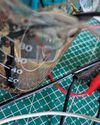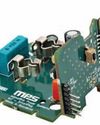OBJECT DETECTION Using ESP32 Cam
Electronics For You
|December 2022
DO-IT-YOURSELF: PROJECT

An ESP32 camera (cam) can take pictures at 2MB per second rate and transmit them up to 200 metres using a small antenna on 2.4GHz. But when it teams up with an internet-enabled network it can do artificial intelligence (AI) related work as well.

In this project the ESP32 cam takes and sends the pictures to a remote computer that is connected to the internet, pulls the specified AI model, and analyses the object (model) to identify it. It then sends the object’s identity back to the ESP32 cam, which then executes the object-specific command entrusted to it.
When the detection computer is on, the ESP32 cam is all vigilant and ready for action. Once the model is loaded (identified), an active internet connection is no longer required. However, the computer needs to remain on all the time.
The ESP32 cam also reproduces the live feed from the ESP32 camera. The IP address is set as fixed type (192.168.43.11), which can be changed as per requirement.
The ESP32 continuously draws the image boundary over the image. If it finds two images, it draws two boundaries, and so on. Its confidence level can be set from 0 to 100%.
Image Resolution, MirrorImage, Flash (on 100% switch on the in-built LED), Quality, Brightness, and Contrast (see Fig. 6) can be changed. However, on increasing image resolution from 320×240 to 1600×1200 the system become extremely slow. It is better to leave the control at the default level and change only if necessary. Author’s prototype is shown in Fig. 1.
Denne historien er fra December 2022-utgaven av Electronics For You.
Abonner på Magzter GOLD for å få tilgang til tusenvis av kuraterte premiumhistorier og over 9000 magasiner og aviser.
Allerede abonnent? Logg på
FLERE HISTORIER FRA Electronics For You

Electronics For You
Tech Majors Are Racing TOWARDS NET-ZERO - What About You?
Apple, Microsoft, Amazon, Google, Infosys, Wipro—global and Indian firms are heading closer to achieving net-zero emissions, a mandate to combat climate change. Here is what you need to know to start your journey...
12 mins
December 2025

Electronics For You
Miniature IoT WATER TDS And LEVEL MONITOR Cum CONTROLLER
For setups that rely on stored water, clear awareness of tank level and water quality is essential.
3 mins
December 2025

Electronics For You
The Impact Of GENERATIVE AI On The Future Of AUTOMOTIVE AND EVs
Autonomous vehicles, connected ecosystems, and smart factories are only the beginning. Generative Al is pushing the auto industry beyond predictions into a bold era of creativity-from EV design to real-time diagnostics and showroom automation. Here is how GenAl is reshaping innovation across the automotive value chain.
8 mins
December 2025

Electronics For You
How AI Tools Are Making SOFTWARE DEVELOPMENT BETTER
AI is reshaping how we code, debug, and collaborate. From Copilot to automation, it is changing software development in ways worth exploring.
3 mins
December 2025
Electronics For You
How AI Tools Are Making SOFTWARE DEVELOPMENT BETTER
AI is reshaping how we code, debug, and collaborate. From Copilot to automation, it is changing software development in ways worth exploring.
3 mins
December 2025

Electronics For You
5 Interesting Reference Designs FOR SMART HOMES
Smart home devices are transforming the way people interact with their appliances. They make homes more convenient, secure, and energy-efficient. From smart plugs and energy monitors to smart locks and thermostats, reference designs help design engineers create connected products that are easy to use, consume less power, and are reliable. These designs allow you to control devices remotely, track energy use, extend battery life, and automate routines. They provide practical solutions for upgrading homes and small commercial spaces without major modifications.
3 mins
December 2025

Electronics For You
Fancy USB LED VASE
This USB LED vase is a simple yet elegant device that fuses art with electronics to create a decorative lighting display. Powered directly from a standard USB port, it uses readily available components such as MOSFETs, resistors, capacitors, and LEDs to produce a striking, dynamic sequence of lights.
3 mins
December 2025

Electronics For You
"WHAT OTHERS SELL IN FOUR BOXES WE BUILT IN ONE"
Years of custom field work are shaping a product line with its own cloud, its own hardware, and a market that is now beginning to recognise its value.
8 mins
December 2025

Electronics For You
BUILD LARGE LANGUAGE MODELS
Large language models are machine learning models designed for a range of language-related tasks such as text generation and translation. Here’s how open source software can help you build your own large language model.
6 mins
December 2025

Electronics For You
Rare Earth Or Rare Ingenuity? India Remains Between The Two
With China firmly controlling rare earth exports, India confronts a critical moment in its technological trajectory.
8 mins
December 2025
Translate
Change font size

